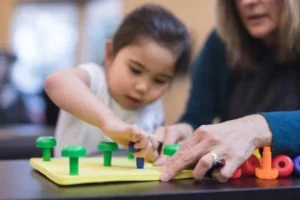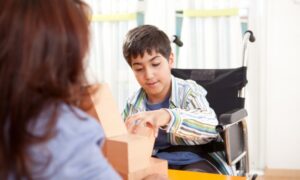If you have a child with ADHD, you may be wondering if occupational therapy can help. The answer is yes- occupational therapy can be an extremely effective treatment for children with ADHD. In this blog post, we will discuss the benefits of occupational therapy for kids with ADHD, and we will provide tips on how to find a qualified therapist.
Contents
What Is OT Therapy?
 Occupational therapy (OT) is a type of healthcare service that uses meaningful activities to support individuals with physical, mental, or developmental disabilities. OT helps people achieve independence and improved quality of life by addressing the challenges they face in everyday activities.
Occupational therapy (OT) is a type of healthcare service that uses meaningful activities to support individuals with physical, mental, or developmental disabilities. OT helps people achieve independence and improved quality of life by addressing the challenges they face in everyday activities.
It is often believed that occupational therapy is solely focused on helping people with disabilities. However, OT can also be used to help people of all ages and abilities manage stresses in their lives as well as to recover from illness or injury.
Therefore, if you feel like you are struggling with everyday tasks, occupational therapy may be able to help. Through therapeutic activities and exercises, OT focuses on improving your physical, mental, and emotional well-being. So that you can reach your maximum potential in terms of independence and quality of life.
Is OT Therapy For ADHD Helpful?
As ADHD is a neurological disorder, OT therapy may be beneficial for some individuals. OTs can help those with ADHD to develop strategies to better manage their symptoms and improve their functioning in daily life. Strategies such as organizing items, improving handwriting skills, or learning how to focus attention can all be useful for managing ADHD symptoms.
According to studies, OT therapy can be beneficial for those with ADHD. It helps them to develop better organizational skills and foster better study habits, enabling them to stay on task more effectively throughout the day. Many people with ADHD find OT therapy to be helpful in enhancing their self-regulation skills. And allowing them to understand and control their emotions better.
The effectiveness of OT therapy for ADHD can be enhanced when combined with other therapies. Be sure to consult with your physician or mental health provider to determine the best treatment plan for you. It’s important to remember that no single type of therapy is a one-size-fits-all solution, and that individual needs vary from person to person.
What Techniques Are Involved In OT Therapy For ADHD?
 When you are practicing occupational therapy for ADHD, you will use a variety of techniques to help your client. Some of the most common techniques include:
When you are practicing occupational therapy for ADHD, you will use a variety of techniques to help your client. Some of the most common techniques include:
Cognitive behavioral therapy (CBT)
The one-on-one counseling that takes place in CBT helps your client learn how to better respond to situations and develop strategies for managing their ADHD symptoms. For example, you may guide your client to become aware of their own thoughts and feelings and then encourage more productive behavior.
Sensory integration therapy
This type of occupational therapy focuses on helping the client recognize, identify, and appropriately react to environmental inputs. This can be very helpful in helping someone with ADHD better regulate their behavior and better manage their symptoms. It can also help to improve their concentration and ability to stay focused.
Social skills training
One key component of occupational therapy for ADHD is helping the client learn how to better interact with others. Social skills training can help your client identify and practice appropriate social behavior, such as eye contact, body language, and how to start or end a conversation. This type of therapy can also help them learn how to communicate more effectively and appropriately.
Motor skills training
This type of occupational therapy helps the client develop better hand-eye coordination, balance, and strength. It can help them improve their ability to focus and manage their ADHD symptoms more effectively. For example, a person may learn how to play ball or use a computer mouse more efficiently.
These are just some of the techniques that occupational therapists may use to help people with ADHD better manage their symptoms. With the right combination of techniques, occupational therapists can help their clients develop the skills and strategies necessary to lead a more productive and successful life.
What Are The Benefits Of OT Therapy For ADHD?
If you have a child with Attention Deficit Hyperactivity Disorder (ADHD), you may be considering Occupational Therapy (OT) as a potential form of treatment. Here are a few benefits of OT therapy for those with ADHD.
1. Strengthening core skills: It focuses on strengthening the core foundational and functional skills necessary to help a child with ADHD develop independence. This can involve activities like sensory integration, visual-motor coordination, fine motor coordination, gross motor coordination, and executive functioning skills like organizing and planning tasks.
2. Addressing underlying issues: This helps to address any underlying physical, environmental, or psychological factors that may be contributing to a child’s ADHD symptoms and behaviors. Targeting these areas can help reduce the severity of ADHD symptoms and improve the overall quality of life for those affected.
3. Fostering self-regulation: The therapists work with children to promote self-regulation, which involves a child’s ability to monitor and manage their own behavior. This can involve activities such as calming/relaxation techniques, organizational strategies, and problem-solving skills.
4. Improving focus and attention: Another benefit of OT therapy for ADHD is that it can help to improve focus and attention. Many people with ADHD struggle with focusing, so by teaching strategies and activities that help to improve focus, OT can have a positive effect on the symptoms of ADHD.
These are just a few of the many benefits of OT therapy for those with ADHD. If you’re considering occupational therapy as a form of treatment for your child, be sure to talk with your doctor or occupational therapist to discuss the best approach for your child’s individual needs.
Is ADHD Curable With Therapy?
 Generally, therapy isn’t seen as a cure for ADHD, but it can be an effective way of managing symptoms. Cognitive behavioral therapy (CBT) and other types of behavioral therapies are common treatments used to help people cope with their symptoms and improve functioning.
Generally, therapy isn’t seen as a cure for ADHD, but it can be an effective way of managing symptoms. Cognitive behavioral therapy (CBT) and other types of behavioral therapies are common treatments used to help people cope with their symptoms and improve functioning.
CBT has been found to be particularly helpful in helping children manage impulsivity, hyperactivity, and inattention. As well as teaching them important skills like organization and time management. Additionally, therapies such as social skills training can help children with ADHD better interact with others and understand how their behavior affects those around them.
Many studies have also found that parent training can be an effective treatment for children with ADHD. Parenting skills such as positive reinforcement, consistent discipline, and behavior modification can help children learn to manage their symptoms and behaviors more effectively.
How Can I Fix My ADHD Without Therapy?
Well, there are many ways to address and manage ADHD without therapy. Some of these include:
- Developing a daily routine and sticking to it. This can help you stay focused and organized, making it easier to concentrate on tasks that need to be done.
- Eating well. Eating nutritious meals regularly helps maintain energy levels throughout the day and can also help with symptoms of ADHD.
- Exercising regularly. Physical activity can help improve brain function and reduce stress.
- Minimizing distractions. It’s important to avoid things that may be distracting you, such as electronics and loud noises.
- Practicing mindfulness techniques, such as meditation and deep breathing, can help you focus your attention and reduce stress.
- Getting enough sleep. Sleep is essential for cognitive performance, so it’s important to get at least seven hours of restful sleep each night.
- Taking breaks throughout the day can help reset your concentration and give your brain a much-needed break from focusing on one task for too long.
- Finding a hobby or activity that you can focus on and enjoy. This can help your brain refocus and reduce stress.
- Make sure to take time for yourself each day, even if it’s just thirty minutes of relaxing activities like reading, listening to music, or taking a walk.
Lastly, it’s important to remember that managing ADHD without therapy isn’t easy, but it can be done. It is essential to be consistent with whatever strategies you choose and to practice patience and self-compassion when things don’t go as planned. With dedication and determination, you can successfully manage your ADHD without therapy.
Conclusion
To conclude, OT therapy for ADHD is considered to be a promising treatment option. It is non-invasive, easy to access, and can be tailored to meet the individual needs of each person. OT-based interventions have been found to be effective in improving attention, executive functioning, academic performance, and behavior in children with ADHD.
As research continues into this field, it is likely that more specific treatments for ADHD will be developed. But for now, OT therapy is an important step in the right direction. By combining traditional treatments with occupational therapy, individuals with ADHD can benefit from a comprehensive approach to managing their disorder.
For more information, please contact MantraCare. ADHD is a neurodevelopmental disorder characterized by difficulty paying attention, hyperactivity, and impulsivity. If you have any queries regarding Online ADHD Counseling experienced therapists at MantraCare can help: Book a trial ADHD therapy session


